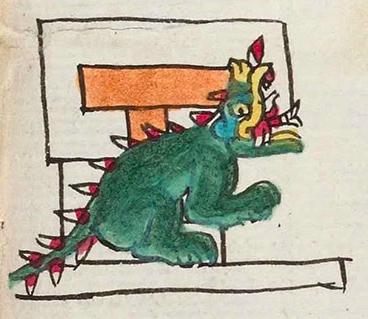Oxichan (Mdz49r)
This compound glyph for the place name Oxichan (unless the gloss is incorrect), includes two prominent elements. One is what appears to be a spiny animal, such as the crocodilian cipactli. The animal is shown in profile, facing to the viewer's right. It is primarily painted a two-tone green, with the lighter color in the area of the belly. The spines are red at their base and white at their tips. The mouth of the animal is red and yellow, reminiscent of the earth monster/cave [oztotl)). Behind the animal is a house that, in this case, stands for home (chantli), even though it is indistinguishable visually from a calli.
Stephanie Wood
As Frances Karttunen notes, the "i" in the middle of the place name suggests a third-person singular possessive pronoun. So, the -chan (from chantli, home) could be possessed by the creature. As in the placement of element for the glyph Cuauhtinchan (or Cuauhtin Inchan), the figure is superimposed over the chan, perhaps creating a visual possessive of the kind suggested by Gordon Whittaker. In a presentation at the Library of Congress (4/18/2023), Whittaker also added that calli becomes chan when there is another sign superimposed on it.
Another possibility could be that the oxi- stem comes from oxitl, a resinous, medicinal unguent, which does lend itself to other place names. The home or source of oxitl, could be the resulting analysis, possibly resulting in a spelling of Oxiichan, if the two i's should not be elided.
While Karttunen does not embrace "Oxomoco" as the root of this place name (saying that it would not be shortened to just Ox-), she does not proffer a guess for the Ox- stem. Berdan and Anawalt relay that Clark (1938 2:52) suggests the animal is a cipactli (caiman), and they note that Peñafiel identifies it as a cuauhcuetzpalin (iguana). Whittaker (4/18/2023) is exploring the possibility of oxitl in its meaning as the breadnut tree, which is a "world tree," with a large rough trunk that has been compared to the jaws of a dragon or crocodile.
Stephanie Wood
oxichan.puo
Oxichan, pueblo
Stephanie Wood
c. 1541, but by 1553 at the latest
Stephanie Wood
houses, casas, homes, hogares, monstruos, animales, lagartos, iguanas, caimanes, cipac, cipactli, caiman, cocodrilo, cocodrilos, crocodiles, nombres de lugares
Photo, by Robert Haskett, at the Templo Mayor, 2/15/2023. Shows an autonomous-era stone carving of a crocodile (cipactli), considered an Earth Monster, whose skin was simulated in offerings with layers of "coral, mollusk shells, sea urchins, sand dollars, and so forth," according to the sign.

oxi(tl), a resinous, medicinal unguent, https://nahuatl.wired-humanities.org/content/oxitl
chan(tli), home, https://nahuatl.wired-humanities.org/content/chantli
cipac(tli), crocodilian monster, https://nahuatl.wired-humanities.org/content/cipactli
cuetzpalin, lizard or iguana, https://nahuatl.wired-humanities.org/content/cuetzpalin
(see the glyph analysis field)
"Home of Oxomoco" (Berdan and Anawalt, 1992, vol. 1, 197)
Codex Mendoza, folio 49 recto, https://digital.bodleian.ox.ac.uk/objects/2fea788e-2aa2-4f08-b6d9-648c00..., image 108 of 188.
The Bodleian Libraries, University of Oxford, hold the original manuscript, the MS. Arch. Selden. A. 1. This image is published here under the UK Creative Commons, “Attribution-NonCommercial-ShareAlike 3.0 License” (CC-BY-NC-SA 3.0).





